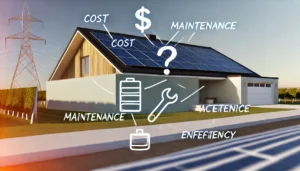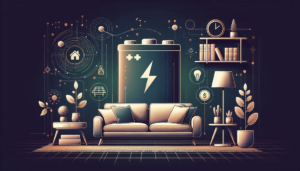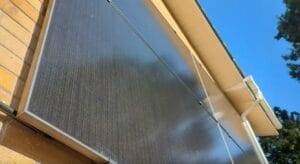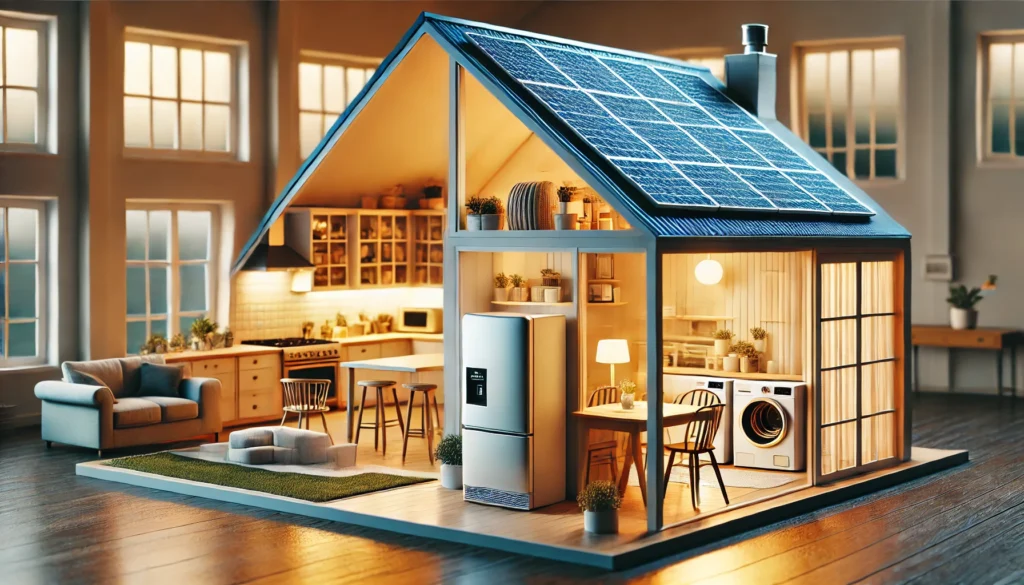
Introduction
Since installing solar panels in our home, life has taken a noticeable turn for the better. While reducing electricity bills is the most apparent benefit, we’ve discovered several other aspects. In this article, I’ll share how our home solar system has provided financial savings and granted our family valuable insights into our energy consumption habits. We’ll delve into the newfound sense of energy abundance and the lifestyle changes we’ve embraced to maximize our savings.
Understanding How a Solar System Works
Many people misunderstand how solar energy production fluctuates. A common misconception is that the size of the system equates to a constant energy output. However, this isn’t the case. Let’s break down some key points:
System Capacity vs. Actual Production
- Rated Capacity: Solar systems are often described by their peak capacity (e.g., 5 kW, 6 kW). This figure represents the maximum power the system can produce under ideal conditions.
- Variable Output: Actual energy production varies throughout the day based on factors like sunlight intensity, weather conditions, and the orientation of the panels.
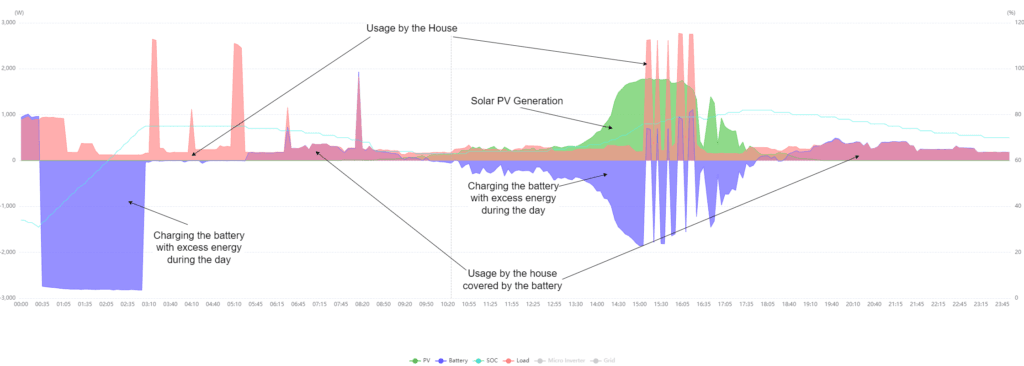
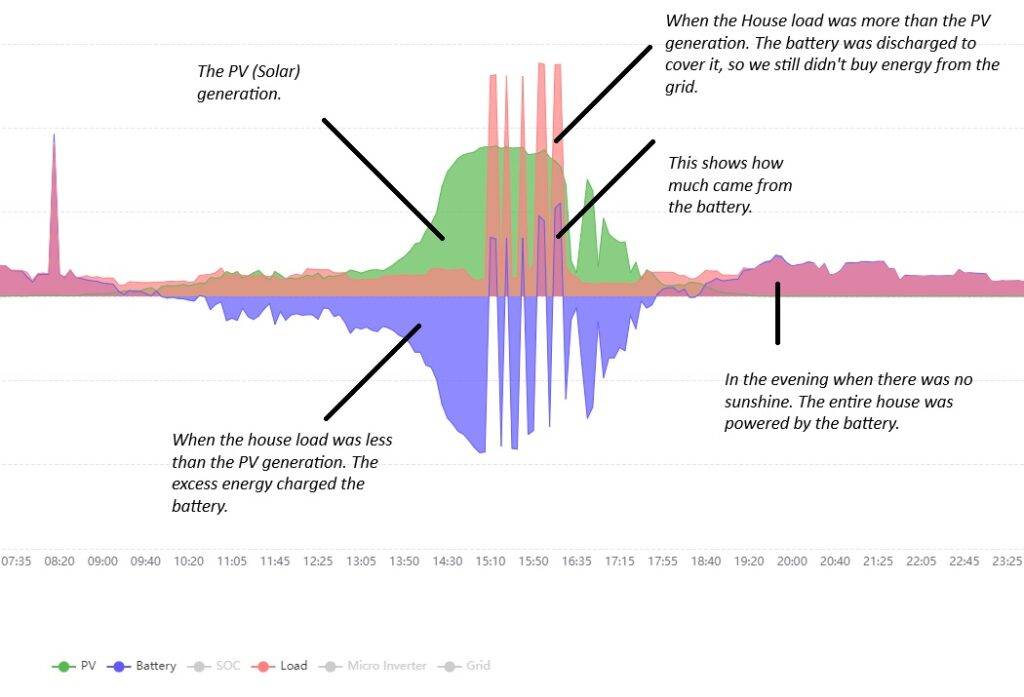
Factors Affecting Solar Energy Production
Sunlight and Panel Orientation
- East-Facing Panels: Capture sunlight in the early part of the day.
- West-Facing Panels: Receive more sunlight in the late afternoon.
- Obstructions: Trees, chimneys, and other structures can cast shadows, reducing efficiency.
Weather Conditions
- Cloud Cover: Overcast days significantly decrease energy production.
- Rain and Snow: Rain can obstruct sunlight, though it can help clean the panels.
Inverter Capacity
- The Inverter converts direct current (DC) from the panels into alternating current (AC) for home use. Panels alone can’t be plugged directly into the home’s electric system.
- Size Matters: The inverter’s capacity often dictates the maximum amount of energy that can be utilized at any given time.

Living with Solar Panels: Changes and Challenges
Energy Production Isn’t Constant
Understanding that solar energy production isn’t constant has led us to adopt strategies to optimize our energy use:
- Timing Appliance Use: Running high-energy appliances when solar production is at its peak.
- Monitoring Consumption: Using apps and displays to monitor energy production and usage.
Vacation and Downtime
Solare panels and home solar systems generally don’t require extra caution when the property isn’t inhabited for extended periods, for example, during an absence for a holiday.
- No Worries When Away: Solar panels are low-maintenance. If the energy they produce isn’t consumed or exported, the inverter limits the production to match the load or to zero.
- No Need for Oversight: The system doesn’t require management to handle unconsumed energy.
Adjusting Our Habits for Maximum Savings
Mindful Energy Use
To get the most out of our solar system, we’ve become more conscious of:
- Simultaneous Appliance Use: Avoid running multiple high-energy devices simultaneously to stay within the inverter’s capacity.
- Peak Sunlight Hours: Scheduling tasks like laundry and dishwashing during peak production times.
Table: Common Household Appliances and Their Energy Consumption
| Appliance | Average Power Consumption (kW) | Optimal Usage Time |
|---|---|---|
| Oven | 2.2 | Midday (when sunny) |
| Washing Machine | 1.0 – 2.0 | Early afternoon |
| Dishwasher | 1.5 – 2.0 | Midday to early evening |
| Electric Vehicle Charging | 3.0 – 7.0 | Overnight (if on cheap tariff) |
Understanding Our Base Load
Every home has a base load—the minimum level of energy consumption due to appliances that are always on:
- Common Base Load Devices:
- Internet routers
- Refrigerators and freezers
- Standby electronics (TVs, computers)
- Awareness Leads to Savings: By identifying these, we’ve reduced unnecessary consumption, such as unplugging devices not in use.
The Benefits of Energy Monitoring
Having access to real-time data on our energy production and consumption has been enlightening:
- Visual Feedback: Apps and displays show how much energy we produce and use.
- Identifying Patterns: Recognizing when appliances consume the most energy helps us make more intelligent choices.
- Family Education: Everyone in the household becomes more energy-conscious.
The Unexpected Perks: Cheap Energy and Abundance
Leveraging Off-Peak Tariffs
- Battery Storage: Our system includes a battery that stores cheap energy purchased overnight.
- Cost Savings: Using stored energy during peak hours reduces our reliance on expensive grid electricity.
Feeling of Abundance
- Energy Freedom: Knowing we have ample energy allows us to use appliances more liberally during peak production times.
- Comfort Enhancements: We can heat or cool our home as needed without worrying about high energy bills.
Since installing solar, we’ve continuously upgraded our household with appliances that improve our comfort. Of course, not having solar energy has never stopped us from doing so before, but now, with abundant renewable energy, it feels much better.
A simple dehumidifier can consume much energy, but we’re running ours 24/7 without concerns. We also added air purifiers and, most importantly, installed a mini-split AC unit.
Strategies for Maximizing Solar Benefits
Staggering Appliance Use
- Avoiding Overloads: By not running multiple high-consumption appliances simultaneously, we stay within our inverter’s capacity and maximize self-consumption.
- Example: Running the washing machine after the dishwasher has finished.
Planning Ahead
- Weather Considerations: We plan to do more energy-intensive tasks on sunny days.
- Scheduling: Setting timers on appliances to run during peak solar production hours.
Conclusion
Installing solar panels has been a transformative experience for our family. Beyond the obvious financial savings, we’ve gained a deeper understanding of our energy use and positively changed our habits. The sense of energy abundance has improved our quality of life, allowing us to enjoy our home without the constant worry of rising energy costs. If you’re considering switching to solar, know that the benefits extend far beyond your wallet—they can truly change how you live.
Thank you for reading! If you found this article insightful, share it with others interested in solar energy and sustainable living.


